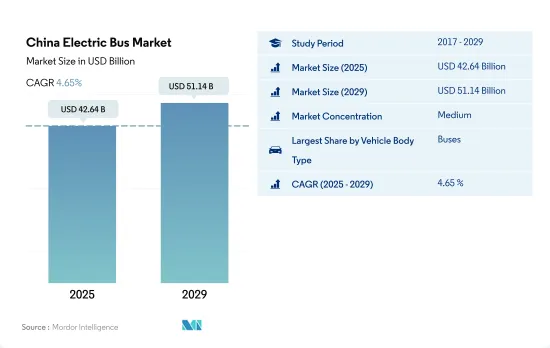 |
市场调查报告书
商品编码
1693625
中国电动公车市场:市场占有率分析、产业趋势与统计、成长预测(2025-2030)China Electric Bus - Market Share Analysis, Industry Trends & Statistics, Growth Forecasts (2025 - 2030) |
||||||
※ 本网页内容可能与最新版本有所差异。详细情况请与我们联繫。
预计2025年中国电动公车市场规模将达到426.4亿美元,到2029年预计将达到511.4亿美元,预测期间(2025-2029年)的复合年增长率为4.65%。

中国电动公车市场趋势
政府措施和强劲的OEM投资推动中国电动车销售快速成长
- 政府减少汽车燃料排放的计画正在鼓励消费者转向更环保的汽车。 2020年11月,中国政府宣布将在2035年前禁止石化燃料汽车,并承诺在新能源计画下销售100%新能源汽车。这导致对电动车的需求增加。透过采取此类法规,中国近年来加强了电动车及其所用各种电池组的销售。
- 政府为消费者和製造商推出了各种计划和奖励,以促进和加强该国对电动车的需求。 2022年5月,政府宣布重新引入补贴计划,以增加电动车的销售量。此外,政府还将为购买电动车的客户提供1,500美元的补贴。这些因素正在鼓励消费者投资电动车,2022 年电动车销量将比 2021 年成长 2.90%。
- 电动车需求的不断增长迫使OEM计划扩大电动车类别的开发和生产。 2021年,通用汽车宣布计划在2025年将电动和自动驾驶汽车方面的支出增加到200亿美元。该公司计划在2023年推出20款新型电动车,并计划在中国每年销售超过100万辆电动车。因此,预计这些因素将在 2024 年至 2030 年期间推动中国电动车市场的发展。
中国电动公车产业概况
中国电动客车市场格局适度整合,前五大企业市占率合计为59.80%。市场的主要企业有:奇瑞汽车、重庆长安汽车股份有限公司、金龙联合汽车工业、浙江吉利控股集团和郑州宇通客车(按字母顺序排列)
其他福利
- Excel 格式的市场预测 (ME) 表
- 3个月的分析师支持
目录
第一章执行摘要和主要发现
第二章 报告要约
第三章 引言
- 研究假设和市场定义
- 研究范围
- 调查方法
第四章 产业主要趋势
- 人口
- 人均GDP
- 消费者汽车支出(cvp)
- 通货膨胀率
- 汽车贷款利率
- 共乘
- 电气化的影响
- 电动车充电站
- 电池组价格
- 新款 Xev 车型发布
- 燃油价格
- OEM生产统计
- 法律规范
- 价值炼和通路分析
第五章市场区隔
- 燃料类别
- BEV
- FCEV
- HEV
- PHEV
第六章 竞争格局
- 重大策略倡议
- 市场占有率分析
- 商业状况
- 公司简介
- Anhui Ankai Automobile Co. Ltd.
- BYD Auto Co. Ltd.
- Chery Automobile Co. Ltd.
- Chongqing Changan Automobile Company Limited
- CRRC Electric Vehicle Co. Ltd.
- FAW Toyota Motor Co. Ltd.
- Higer Bus Company Ltd.
- King Long United Automotive Industry Co. Ltd.
- Nanjing Golden Dragon Bus Co. Ltd.
- Shanghai Sunwin Bus Corporation.Ltd.
- Zhejiang Geely Holding Group Co. Ltd
- Zhengzhou Yutong Bus Co. Ltd.
- Zhongtong Bus Holding Co. Ltd.
第七章:CEO面临的关键策略问题
第 8 章 附录
- 世界概况
- 概述
- 五力分析框架
- 全球价值链分析
- 市场动态(DRO)
- 资讯来源及延伸阅读
- 图片列表
- 关键见解
- 数据包
- 词彙表
The China Electric Bus Market size is estimated at 42.64 billion USD in 2025, and is expected to reach 51.14 billion USD by 2029, growing at a CAGR of 4.65% during the forecast period (2025-2029).

China Electric Bus Market Trends
Government initiatives and strong OEM investments drive rapid drowth in electric vehicle sales in China
- The programs launched by the government to reduce gas emissions caused by vehicle fuels are encouraging consumers to shift to green vehicles. In November 2020, the government of China announced a ban on fossil fuel vehicles by 2035, clearly stating the selling of 100% new energy vehicles under the new energy program. As a result, the demand for electric cars increased. Adopting such regulations enhanced the sales of electric cars and various types of battery packs used in them in China in recent years.
- The government is introducing various schemes and incentives for customers and manufacturers to promote and enhance the demand for electric vehicles in the country. In May 2022, the government announced the reintroduction of the subsidy program to increase the sales of electric vehicles. Moreover, the government will allocate a subsidy of USD 1500 to customers opting for an electric car. Such factors have encouraged customers to invest in electric mobility, which further has increased the sales of electric cars by 2.90% in 2022 over 2021 in China.
- The growing demand for electric vehicles has forced OEMs to plan to increase development and production in the electric vehicle category. In 2021, General Motors announced its plans to raise its spending on electric and autonomous vehicles to USD 20 billion by 2025. The company is expected to launch 20 new electric models by 2023 and aims to sell more than 1 million electric cars a year in China. As a result, these factors are expected to drive the electric vehicle market in China during the 2024-2030 period.
China Electric Bus Industry Overview
The China Electric Bus Market is moderately consolidated, with the top five companies occupying 59.80%. The major players in this market are Chery Automobile Co. Ltd., Chongqing Changan Automobile Company Limited, King Long United Automotive Industry Co. Ltd., Zhejiang Geely Holding Group Co. Ltd and Zhengzhou Yutong Bus Co. Ltd. (sorted alphabetically).
Additional Benefits:
- The market estimate (ME) sheet in Excel format
- 3 months of analyst support
TABLE OF CONTENTS
1 EXECUTIVE SUMMARY & KEY FINDINGS
2 REPORT OFFERS
3 INTRODUCTION
- 3.1 Study Assumptions & Market Definition
- 3.2 Scope of the Study
- 3.3 Research Methodology
4 KEY INDUSTRY TRENDS
- 4.1 Population
- 4.2 GDP Per Capita
- 4.3 Consumer Spending For Vehicle Purchase (cvp)
- 4.4 Inflation
- 4.5 Interest Rate For Auto Loans
- 4.6 Shared Rides
- 4.7 Impact Of Electrification
- 4.8 EV Charging Station
- 4.9 Battery Pack Price
- 4.10 New Xev Models Announced
- 4.11 Fuel Price
- 4.12 Oem-wise Production Statistics
- 4.13 Regulatory Framework
- 4.14 Value Chain & Distribution Channel Analysis
5 MARKET SEGMENTATION (includes market size in Value in USD and Volume, Forecasts up to 2029 and analysis of growth prospects)
- 5.1 Fuel Category
- 5.1.1 BEV
- 5.1.2 FCEV
- 5.1.3 HEV
- 5.1.4 PHEV
6 COMPETITIVE LANDSCAPE
- 6.1 Key Strategic Moves
- 6.2 Market Share Analysis
- 6.3 Company Landscape
- 6.4 Company Profiles
- 6.4.1 Anhui Ankai Automobile Co. Ltd.
- 6.4.2 BYD Auto Co. Ltd.
- 6.4.3 Chery Automobile Co. Ltd.
- 6.4.4 Chongqing Changan Automobile Company Limited
- 6.4.5 CRRC Electric Vehicle Co. Ltd.
- 6.4.6 FAW Toyota Motor Co. Ltd.
- 6.4.7 Higer Bus Company Ltd.
- 6.4.8 King Long United Automotive Industry Co. Ltd.
- 6.4.9 Nanjing Golden Dragon Bus Co. Ltd.
- 6.4.10 Shanghai Sunwin Bus Corporation.Ltd.
- 6.4.11 Zhejiang Geely Holding Group Co. Ltd
- 6.4.12 Zhengzhou Yutong Bus Co. Ltd.
- 6.4.13 Zhongtong Bus Holding Co. Ltd.
7 KEY STRATEGIC QUESTIONS FOR VEHICLES CEOS
8 APPENDIX
- 8.1 Global Overview
- 8.1.1 Overview
- 8.1.2 Porter's Five Forces Framework
- 8.1.3 Global Value Chain Analysis
- 8.1.4 Market Dynamics (DROs)
- 8.2 Sources & References
- 8.3 List of Tables & Figures
- 8.4 Primary Insights
- 8.5 Data Pack
- 8.6 Glossary of Terms










